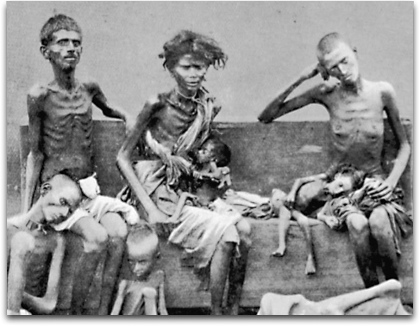The statement is correct, and famines in India were directly related to the economic policies that the colonial masters adopted. The significant difference between the British colonist and earlier invaders was that the former was here to stay and establish their rule and the latter drained the Indian economy to serve their own country. Therefore they created structural changes to drain India’s wealth as tribute.
Table of Contents
Economic Policies that Led to Famines
The economic policies of the colonial masters that led to a series of famines can be summed up under the following heads.
Impoverishment of Peasantry
The Peasants have to pay a fixed rent to Zamindar from the farm’s produce. The money collected by peasants was by selling the produce to Moneylenders who were often the grain merchant in the market who forced the peasants to sell the produce at a low price to settle their dues.

Emergence of Intermediaries
The old Zamindar was replaced by a new system where the Zamidar has to pay 10/11 share of the rent that they collected from the peasants and keep 1/11 share for themselves. Under the Permanent Settlement, this share will never be increased and remain constant in perpetuity along with the ownership of the land. The Zamindar and the East India Company had a steady stream of income. Even the Zamindars were vulnerable due to a Sunset Clause.
The ‘Sunset Clause’ is that if the Zamindar failed to pay the revenue to the Company on a prefixed date all the rights will be taken away and the land will be auctioned to the highest bidder. This ensured the uprooting of traditional Zamindars and the new ones had no roots in the villages therefore they had no incentive in increasing the quality of the land.
What about peasants?
They had to pay constant rent demanded by zamindar coupled with falling prices, and the destruction of handicrafts + local industries which meant less money in the hands of peasants + constant rent. This situation was ripe for the growth of Moneylenders who lent money to the peasants and Zamindars who were unable to pay rent and revenue respectively. Therefore we can see a trend in shifting ownership of the land. The Zamidars resorted to summary evictions, illegal dues, and ‘begar’ a practice when a laborer was forced to work without being paid or being paid a nominal remuneration.

Stagnation and Deterioration of Agriculture
There was little to no expenditure in order to improve the productivity and quality of the land. There was no incentive in cultivating the land. The Zamindars fragmented the land and all of this made it difficult to introduce modern technology which resulted in low levels of production.
Commercialization of Agriculture
The introduction of commercial crops means less land under cultivation for food grains such as cereals and pulses. It also meant more requirements of nutrients, more labor, more water, and the degradation of land at a faster pace. Crops such as cotton, jute, sugarcane, groundnut, oilseeds, tobacco, etc, and plantations such as tea, coffee, rubber, indigo, etc.
List of Famines in India
- 1769 – 1770 Great Bengal Famine (Bihar, West Bengal) death toll 2-10 Million
- 1783 – 1784 Chalisa Famine (Delhi, Western Oudh, Eastern Punjab region, Rajputana, and Kashmir) death toll 10 Million +
- 1791 – 1792 Doji Bara famine or Skull famine (Hyderabad, Southern Maratha country, Deccan, Gujarat, and Marwar) death toll 10 Million +
- 1837 – 1838 Agra Famine (Central Doab and trans-Jumna districts of the North-Western Provinces (later Agra Province), including Delhi and Hissar) death toll 800,000
- 1860 – 1861 Upper Doab (Upper Doab of Agra; Delhi and Hissar divisions of Punjab) death toll 2 Millon
- 1865 – 1867 Orissa Famine (Orissa, Bihar, Bellary, and Ganjam) death toll 1 Million
- 1868 – 1870 Rajputana Famine (Ajmer, Western Agra, Eastern Punjab) death toll 1.5 Million
- 1876 – 1878 Great Famine of Southern India (Mysore and Bombay) death toll 5 Million +
- 1896 – 1897 Indian Famine (Madras, Bombay Deccan, Bengal, United Provinces, Central Provinces. Also parts of Punjab specially Bagar tract) death toll 5 Million +
- 1899 – 1900 Indian Famine (Bombay, Central Provinces, Berar, Ajmer. Also parts of Punjab specially Bagar tract) death toll 1 Million +
- 1943 – 1944 Bengal Famine (Bengal Famine) death toll 1.5 Million+
List Source Wikipedia Article Titled Famines under the British Rule
Context
This question was asked in UPSC Civil Services History Paper 2 in the mains examination in the year 2022



